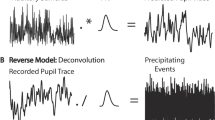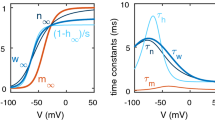Summary
The peri-stimulus-time histogram (PSTH) analysis of stimulus-related neuronal spike train data is usually regarded as a method to detect stimulus-induced excitations or inhibitions. However, for a fairly regularly discharging neuron such as the human α-motoneuron, long-latency modulations of a PSTH are difficult to interpret as PSTH modulations can also occur as a consequence of a modulated neuronal autocorrelation. The experiments reported here were made (i) to investigate the extent to which a PSTH of a human hand-muscle motoneuron may be contaminated by features of the autocorrelation and (ii) to develop methods that display the motoneuronal excitations and inhibitions without such contamination. Responses of 29 single motor units to electrical ulnar nerve stimulation below motor threshold were investigated in the first dorsal interosseus muscle of three healthy volunteers using an experimental protocol capable of demonstrating the presence of autocorrelative modulations in the neuronal response. It was found for all units that the PSTH as well as the cumulative sum (CUSUM) derived from these responses were severely affected by the presence of autocorrelative features. On the other hand, calculating the CUSUM in a slightly modified form yielded — for all units investigated — a neuronal output feature sensitive only to motoneuronal excitations and inhibitions induced by the afferent volley. The price that has to be paid to arrive at such a modified CUSUM (mCUSUM) was a high computational effort prohibiting the on-line availability of this output feature during the experiment. It was found, however, that an interspike interval superposition plot (IISP) — easily obtainable during the experiment — is also free of autocorrelative features. Both mCUSUM and IISP of all 29 units showed a common reflex pattern in response to the electrical stimulation of low-threshold afferents. The first sizeable effect was a motoneuronal inhibition starting 50–70 ms after the stimulus followed by an excitatory period with an onset latency of 90–110 ms. Thereafter, a second inhibitory period with a duration of approximately 100 ms appeared beginning 140–160 ms after the stimulus. These long-lasting effects with long-latency could not be deduced from the “raw” PSTH or the unmodified CUSUM making it necessary to evaluate long-latency reflexes of single motoneurons by calculation of an mCUSUM and — in case of on-line requirements — by construction of an IISP.
Similar content being viewed by others
References
Ashby P, Labelle K (1977) Effects of extensor and flexor group I afferent volleys on the excitability of individual soleus motoneurones in man. J Neurol Neurosurg Psychiatry 40: 910–919
Ashby P, Wiens M (1989) Reciprocal inhibition following lesions of the spinal cord in man. J Physiol 414: 145–157
Ashby P, Zilm D (1982) Characteristics of postsynaptic potentials produced in single human motoneurons by homonymous group I volleys. Exp Brain Res 47: 41–48
Awiszus F (1988) Continuous functions determined by spike trains of a neuron subject to stimulation. Biol Cybern 58: 321–327
Awiszus F (1989) On the description of neuronal output properties using spike train data. Biol Cybern 60: 323–333
Bayoumi A, Ashby P (1989) Projections of group Ia afferents to motoneurons of thigh muscles in man. Exp Brain Res 76: 223–228
Bryant HL, Marcos AR, Segundo JP (1973) Correlations of neuronal spike discharges produced by monosynaptic connections and by common inputs. J Neurophysiol 36: 205–225
Buller NP, Garnett R, Stephens JA (1980) The reflex responses of single motor units in human hand muscles following muscle afferent stimulation. J Physiol 303: 337–349
Darton K, Lippold OCJ, Shahani M, Shahani U (1985) Long-latency spinal reflexes in humans. J Neurophysiol 53: 1604–1618
Datta AK, Stephens JA (1981) The effects of digital nerve stimulation on the firing of motor units in human first dorsal interosseus muscle. J Physiol 318: 501–510
Davey NJ, Ellaway PH, Stein RB (1986) Statistical limits for detecting change in the cumulative sum derivative of the peristim ulus time histogram. J Neurosci Methods 17: 153–166
Ellaway PH (1978) Cumulative sum technique and its application to the analysis of peristimulus time histograms. Electroencephalogr Clin Neurophysiol 45: 302–304
Garnett R, Stephens JA (1980) The reflex responses of single motor units in human first dorsal interosseus muscle following cutaneous afferent stimulation. J Physiol 303: 351–364
Gerstein GL, Kiang NY-S (1960) An approach to the quantitative analysis of electrophysiological data from single neurons. Biophys J 1: 15–28
Kirkwood PA (1979) On the use and interpretation of crosscorrelation measurements in the mammalian central nervous system. J Neurosci Methods 1: 107–132
Knox CK, Poppele RE (1977) Correlation analysis of stimulusevoked changes in excitability of spontaneously firing neurons. J Neurophysiol 40: 616–625
Kudina LP (1988) Excitability of firing motoneurones tested by Ia afferent volleys in human triceps surae. Electroencephalogr Clin Neurophysiol 69: 576–580
Kudina LP, Pantseva RE (1988) Recurrent inhibition of firing motoneurones in man. Electroencephalogr Clin Neurophysiol 69: 179–185
Mao CC, Ashby P, Wang M, McCrea D (1984) Synaptic connections from large muscle afferents to the motoneurons of various leg muscles in man. Exp Brain Res 56: 341–350
Miles TS, Türker KS, Le TH (1989a) Ia reflexes and EPSPs in human soleus motor neurons. Exp Brain Res 77: 628–636
Miles TS, Le TH, Türker KS (1989b) Biphasic inhibitory responses and their IPSPs evoked by tibial nerve stimulation in human soleus motor neurones. Exp Brain Res 77: 637–645
Moore GP, Segundo JP, Perkel DH, Levitan H (1970) Statistical signs of synaptic interaction in neurons. Biophys J 10: 876–900
Person RS, Kozhina GV (1978) Study of orthodromic and antidromic effects of nerve stimulation on single motoneurones of human hand muscles. Electromyogr Clin Neurophysiol 18: 437–456
Stephens JA, Usherwood TP, Garnett R (1976) Technique for studying synaptic connections of single motoneurones in man. Nature 263: 343–344
Williams IR, Hayward M (1981) The effect of afferent stimuli on steadily discharging single motor units in man. J Neurol Neurosurg Psychiatry 44: 1040–1045
Author information
Authors and Affiliations
Rights and permissions
About this article
Cite this article
Awiszus, F., Feistner, H. & Schäfer, S.S. On a method to detect long-latency excitations and inhibitions of single hand muscle motoneurons in man. Exp Brain Res 86, 440–446 (1991). https://doi.org/10.1007/BF00228970
Received:
Accepted:
Issue Date:
DOI: https://doi.org/10.1007/BF00228970




